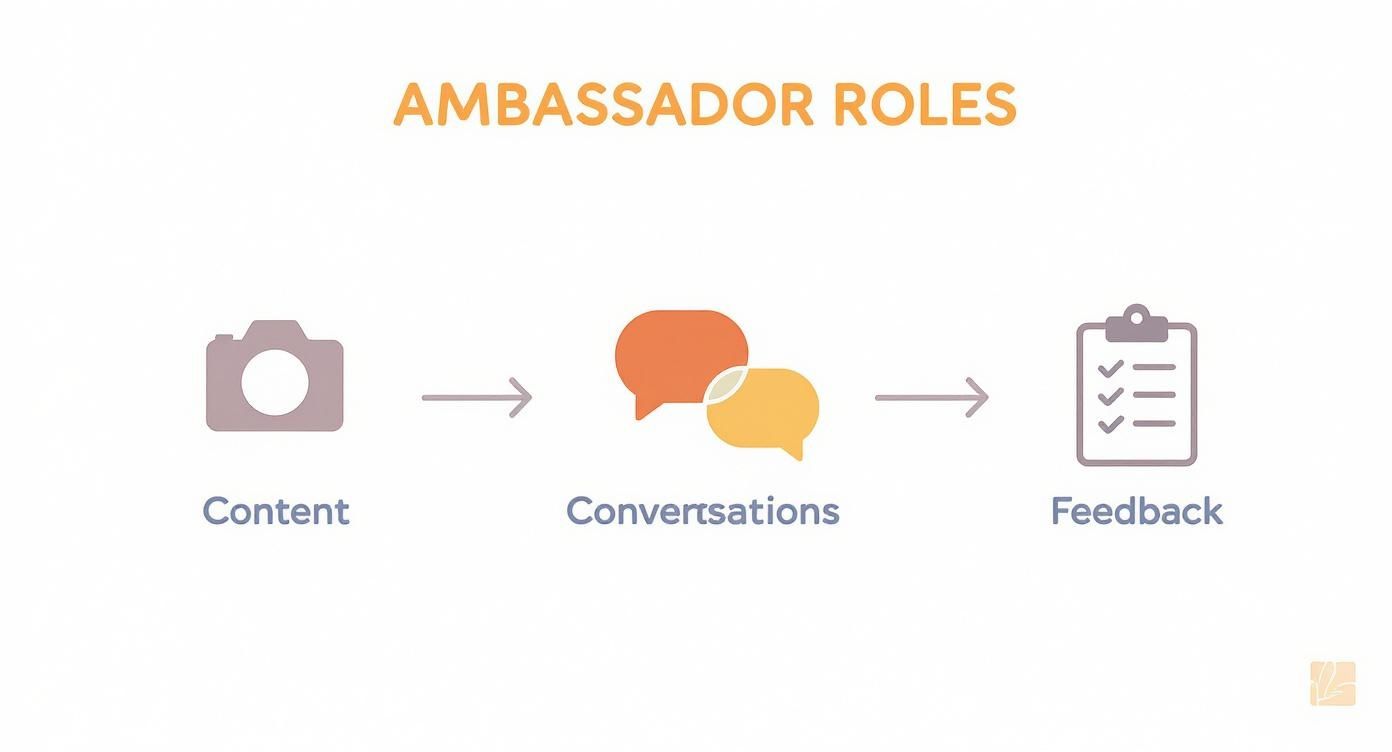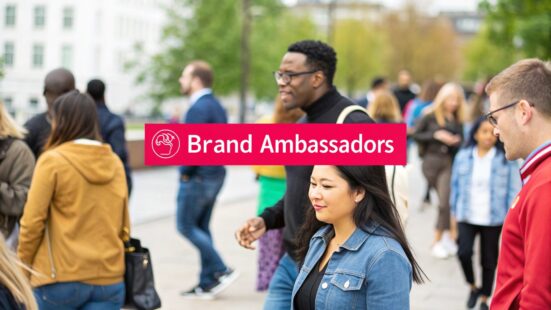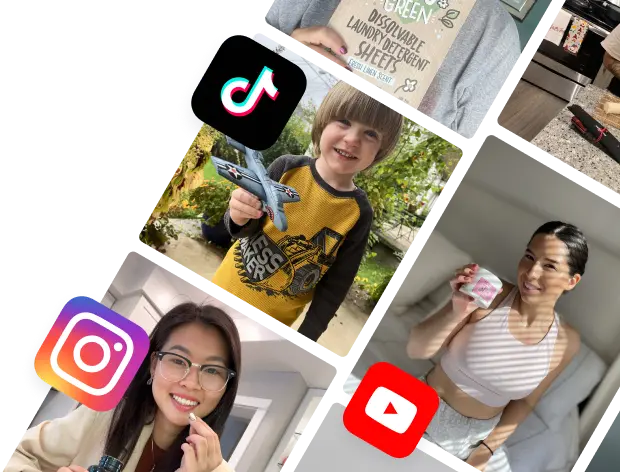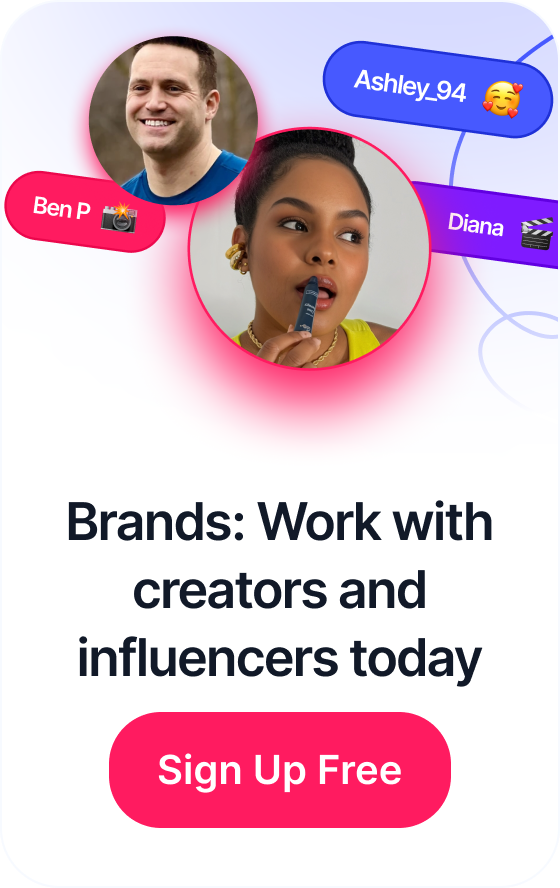 Influencer Marketing Outreach: Your Success Strategy
Influencer Marketing Outreach: Your Success Strategy
Let's be honest, the term "brand ambassador" gets thrown around a lot. But what does it really mean?
Forget the stuffy, dictionary-style definitions. A brand ambassador is, at their core, a genuine fan. They are someone who already uses, loves, and believes in your company so much that they want to shout it from the rooftops.
Think of them as more than just a paid spokesperson. These are real people who weave your products or services into their everyday lives and share those authentic experiences with their own communities.
Table of Contents
What Are Brand Ambassadors Really?

Imagine a brand ambassador as the ultimate word-of-mouth recommendation, just supercharged. We've all become experts at tuning out flashy billboard ads and skipping pre-roll commercials. But an endorsement from a trusted friend? That cuts through the noise.
That's precisely the role an ambassador plays. They are the enthusiastic customers, the savvy industry experts, or even the dedicated employees who are already passionate about what you do. Tapping into that existing passion is what makes this kind of marketing so powerful—it's built on a rock-solid foundation of authenticity and long-term relationships, not just a one-off campaign.
More Than Just a Title
The real magic of a brand ambassador isn't their follower count; it's the trust and credibility they've built within their circle. It's about community. They are often people who are already part of your world, like:
- Your Best Customers: These are the people who have already bought and fallen in love with your products. Their advocacy is as real as it gets.
- Industry Experts: Think of professionals who can lend their authority and credibility to your brand, validating its quality and effectiveness.
- Passionate Community Members: These are the folks who vibe with your brand's mission and values on a deeply personal level.
The big idea here is shifting from transactional promotion to relational advocacy. A true ambassador embodies your brand's spirit, forging a connection with audiences that traditional advertising simply can't touch.
The Evolution of Modern Advocacy
The whole concept of brand advocacy has changed dramatically. Gone are the days when this was a game reserved for A-list celebrities with massive paychecks. The smart brands today are focused on cultivating real, lasting partnerships.
Ambassadors have evolved into long-term partners who genuinely represent a brand's values day in and day out. We're seeing a big shift toward deeper relationships that blend fixed payments with affiliate-style incentives. This reflects a simple truth: these advocates build stronger customer trust and drive repeat business over the long haul. You can dive deeper into the future of ambassador earnings and partnerships to see where things are headed.
By consistently championing your brand, these individuals do something incredibly valuable: they humanize your company. They turn passive consumers into an engaged, loyal community that truly cares.
What a Brand Ambassador Actually Does Day-to-Day
So, what does being a brand ambassador really look like? It’s not about one big, flashy post. Instead, their mission is to consistently and authentically weave a brand into the conversations they're already having in their communities. The goal is to make advocacy feel less like a marketing pitch and more like a helpful recommendation from a friend.
At its core, an ambassador's role is a mix of three key things: creating content people can relate to, sparking real conversations, and acting as a feedback loop for the brand. Think of them as the bridge connecting a company's polished ads to the genuine, messy, real-world experience of its customers.
For example, a skincare ambassador won't just post a slick photo of a new serum. They'll show you their entire morning routine, demonstrating exactly where that product fits in. Or a tech ambassador might jump on Instagram Live for a Q&A, answering unfiltered questions from followers about a new gadget. It’s personal, and it’s not scripted.
Core Ambassador Responsibilities
The daily grind for a brand ambassador is all about building trust and stoking organic interest. They aren't there to hard-sell anyone. Their job is to show a product's value through their own genuine experiences. This means they’re constantly juggling content creation, community engagement, and providing feedback.
Here’s what that usually looks like:
- Creating Authentic Content: This is the most visible part of the job. They’re snapping photos, shooting videos, and creating stories that show a product or service being used in a real-life context—a far cry from overly produced, ad-style content.
- Engaging with Their Community: A huge part of an ambassador's mission is just talking to people. Knowing how to increase social media engagement is everything here. They jump into the comments, answer questions, and start conversations about the brand.
- Providing Valuable Feedback: Ambassadors are the boots on the ground. They hear what people love, what frustrates them, and what they wish a product could do. They feed all those priceless, unfiltered insights back to the brand, helping them make their products even better.
At its heart, an ambassador’s mission is to humanize the brand. They turn a corporate entity into a relatable presence by sharing honest stories, fostering dialogue, and showing genuine enthusiasm.
Bringing the Brand to Life
Ultimately, the goal is to make the brand feel like a natural part of their audience’s world. They don't just promote; they educate, entertain, and build real relationships. This consistent, no-pressure approach is exactly why their advocacy feels so believable and works so well.
Whether it’s an outdoor gear ambassador sharing tips from their latest hike or a food blogger showing how a new ingredient works in a family recipe, their work is all about context. They answer the unspoken question every potential customer has: "How would this actually fit into my life?"
By showing instead of just telling, they build the kind of deep-seated trust that turns curious followers into loyal customers. Their daily mission is a marathon of trust-building, not a sprint for sales.
Brand Ambassadors vs Influencers What's the Difference
You’ve probably heard the terms "brand ambassador" and "influencer" thrown around, often in the same breath. But they’re not the same thing—not even close. Getting this distinction right is key to building a marketing strategy that actually works.
Think of it like this: hiring an influencer is like paying a celebrity for a one-time TV commercial. It’s flashy, gets a lot of eyes on you quickly, and is built for a short-term splash. A brand ambassador, on the other hand, is like partnering with a filmmaker on a multi-year documentary series. This is all about long-term storytelling and building genuine trust.
Relationship and Motivation
The biggest difference comes down to the relationship itself. Influencer marketing is almost always transactional. A brand pays for a specific campaign or a set number of posts, and when the contract is up, the relationship often ends. The main motivation is getting paid to create content for their audience.
Ambassadors are in it for the long haul. They usually start as genuine fans of a brand, people who already love and use the products. Their motivation comes from a real passion for what the company does. While they might get perks or compensation, the partnership feels more like being part of the team than just another paid gig. Understanding how to manage influencer relationships effectively can help clarify these different dynamics.
This infographic gives a great breakdown of what an ambassador actually does in a long-term partnership.

As you can see, their job goes way beyond a single post. It’s about creating content consistently, sparking conversations, and even giving the brand valuable feedback.
An influencer's value is often measured by their audience size and reach for a specific campaign. An ambassador's value is measured by their long-term ability to build trust and community around a brand.
Brand Ambassador vs Influencer A Head-to-Head Comparison
To make the differences even clearer, let's put these two roles side-by-side. This table breaks down the core distinctions, from relationship length to motivation.
| Characteristic | Brand Ambassador | Influencer |
|---|---|---|
| Relationship | Long-term, ongoing partnership | Short-term, campaign-based |
| Motivation | Genuine brand loyalty and passion | Primarily financial compensation |
| Authenticity | High; stems from pre-existing love for the brand | Can be high, but is often perceived as transactional |
| Goal | Build community, trust, and long-term loyalty | Generate immediate buzz, reach, and sales |
| Content | Organic, integrated into daily life | Polished, often with clear "ad" disclosures |
| Commitment | Often exclusive or semi-exclusive | Works with multiple brands, sometimes competitors |
Ultimately, choosing between an ambassador and an influencer depends entirely on what you want to achieve. Are you after a quick burst of visibility or are you playing the long game to build deep-seated loyalty?
The Shift Toward Deeper Partnerships
More and more brands are realizing the power of authentic, long-term relationships. In fact, market studies show that nearly 73% of marketers in the US and UK plan to increase their budgets for ambassador programs in 2025.
Why the change? It’s all about a desire for more authentic content (36%) and a better return on investment (34%), two things that ongoing advocacy delivers far more effectively than one-off campaigns.
Why an Ambassador Program Is a Game Changer

So, is all the buzz about ambassador programs legitimate? Is it really worth the effort to build one from the ground up?
Absolutely. This isn't just another passing marketing fad. A well-run ambassador program is a strategic play that builds a genuine moat of trust around your brand, something that’s getting harder and harder to do in a world drowning in ads.
Think about it. We’re all masters at ignoring slick, polished commercials and sponsored posts that just don’t feel real. What cuts through all that noise? A recommendation from someone we actually trust. Brand ambassadors are those people, giving your company a human voice that connects with audiences who have their guard up.
Building Unbreakable Trust
The single biggest win from an ambassador program is the authentic trust it generates. When someone who genuinely loves and uses your product shares their experience, it doesn't land like an advertisement. It feels more like a great tip from a friend. That kind of advocacy is priceless.
Your ambassadors provide the social proof that your brand actually delivers on what it promises. Their unscripted, real-world content validates your marketing claims and builds a level of credibility that a paid ad campaign could only dream of. This bedrock of trust is what converts curious browsers into loyal, long-term customers.
A Fountain of Authentic Content
One of the best ongoing benefits is the constant stream of user-generated content (UGC) your ambassadors will create. And this isn’t just filler content; it's a living library of authentic, relatable assets you can repurpose across every single one of your marketing channels.
From candid Instagram stories to detailed "how-to" videos on TikTok, this content shows your product being used in real life. It’s exactly what potential customers are looking for before they decide to buy. Instead of pouring money into expensive studio photoshoots, you get a diverse, high-impact collection of visuals that truly resonate.
An ambassador program transforms your marketing from a monologue into a conversation. It invites real users to become the heroes of your brand story, creating a ripple effect of trust and engagement that is impossible to manufacture.
The numbers back this up, big time. Recent stats show that 86% of US marketers now work with creators and influencers. This shift has fueled a global industry now valued at around $33 billion. For B2B brands specifically, 67% use them to boost brand awareness, and 54% lean on them to enhance their credibility.
These figures signal a clear move toward partnership-driven marketing. To get a better sense of where things are headed, you can learn more about the 2025 ambassador marketing landscape and see what's on the horizon.
How to Build a Thriving Ambassador Program
Building a killer ambassador program isn't about throwing money at people with huge follower counts and just hoping it works. Far from it. It's a strategic game that demands clear goals, real relationships, and a solid framework. Think of this as your roadmap to creating a program that actually moves the needle and builds a loyal community around your brand.
It all starts with knowing exactly what you want to accomplish. Are you trying to get your name out there and boost brand awareness? Or are you laser-focused on generating high-quality leads or driving sales for a new product? Your answer here will shape every single decision you make down the line, from the people you recruit to how you'll know if you're winning.
Define Your Program Goals and KPIs
Before you send a single DM, you need to define what success looks like. Without crystal-clear objectives, your program is just a ship without a rudder—drifting aimlessly.
Get specific and set measurable goals. Here are a few common ones:
- Increasing brand awareness: You’ll be tracking metrics like social media reach, brand mentions, and the growth of your follower count.
- Driving conversions: This is all about the numbers. Success here is measured by unique referral codes, affiliate link clicks, and direct sales.
- Boosting engagement: Look at the conversation. Monitor likes, comments, shares, and the buzz happening in your community.
With your goals locked in, you need Key Performance Indicators (KPIs) to track your progress. This isn't just busywork; it's how you know what’s working and what's falling flat, letting you make smart tweaks to your strategy on the fly.
Identify and Recruit the Right Ambassadors
The real heart and soul of your program are the people you bring into the fold. The best ambassadors aren’t just hired guns; they’re people who already have a genuine fire for your brand. Don't get blinded by big follower numbers—look for authenticity and true engagement.
So, where do you find these gems? They're usually hiding in plain sight:
- Passionate Customers: These are your superfans, the people who are already buying, using, and raving about your products. Their advocacy is pure gold because it’s 100% authentic.
- Industry Experts: Think of professionals who have serious credibility in your niche. Their stamp of approval acts as powerful social proof that can win over even the most skeptical customers.
- Engaged Employees: Don't forget to look inward! Your own team can be your most powerful advocates. They know your mission and values inside and out.
When you reach out, make it personal. Don't send a generic copy-paste message. Show them you've noticed their passion and explain exactly why you think they'd be a perfect addition to your inner circle.
Create a Compelling Offer and Clear Guidelines
If you want to attract—and keep—top-tier ambassadors, you have to bring real value to the table. And while cash is great, the most successful programs offer perks that go way beyond a simple paycheck.
A thriving ambassador program is built on a foundation of mutual benefit. The goal is to make your ambassadors feel like true partners in your brand's journey, not just hired help.
Your offer should be a well-rounded mix of incentives. Try including a combination of these:
- Monetary Rewards: This could be commissions on sales, flat fees for specific content, or bonuses for hitting performance goals.
- Exclusive Access: Treat them like VIPs. Give them a sneak peek at new products, share insider info, or invite them to special events.
- Free Products: Keep them fully stocked with your best stuff. This ensures they can create fresh, relevant content that showcases what you have to offer.
- Professional Growth: Help them build their own brand. Offer opportunities like co-hosting a webinar with your team or featuring them on your official channels.
Finally, it's crucial to give them clear guidelines without killing their creative spark. Lay out the key messaging points and any necessary disclosure rules, but then trust them to speak in their own voice. This balance is everything. It's how you get content that feels real and truly connects with people.
A great program can even be a launchpad for smaller creators. For a deeper dive, explore our guide on ambassador programs for small influencers. This approach not only builds stronger partnerships but also ensures your brand message stays consistent and powerful.
Of course. Here is the rewritten section, crafted to sound completely human-written and natural, following all your specific instructions and style guidelines.
Quick Answers About Brand Ambassadors
As you start thinking about building your own ambassador program, the big-picture ideas are exciting. But pretty soon, the practical questions start popping up. How do you pay people? What are the legal rules? How do you even know if it's working?
Getting these details right is what separates a program that fizzles out from one that becomes a powerful growth engine. Let's dig into the nuts and bolts and answer the most common questions brands have when they're ready to get started.
To give you a quick overview, here are some rapid-fire answers to the most pressing questions we hear from brands.
| Question | Answer |
|---|---|
| How should I pay brand ambassadors? | A mix of perks works best. Combine affiliate commissions, free products, exclusive access, and sometimes flat fees for specific tasks. |
| Do they need to disclose the partnership? | Yes, absolutely. Transparency is legally required. Simple hashtags like #Ad or #Sponsored are essential to stay compliant. |
| How do I measure the ROI? | Track what matters to your goals. Use unique codes for sales, monitor referral traffic, and measure audience growth and engagement. |
| What's the difference from an influencer? | Ambassadors are long-term partners who genuinely love your brand. Influencers are often hired for short-term, transactional campaigns. |
These quick answers provide a solid starting point, but let's explore each of these topics in more detail to make sure your program is built on a strong foundation.
How Should I Compensate Brand Ambassadors?
There’s no magic formula for compensation—it really depends on what you want to achieve and what your ambassadors value. While some fans are happy to post in exchange for free products, the most successful programs mix it up to keep everyone motivated for the long haul.
Think of it as creating a "rewards menu" you can pull from:
- Affiliate Commissions: This is a classic for a reason. Ambassadors get a unique link or code, and they earn a cut of every sale they drive. It’s a win-win that directly connects their effort to your revenue.
- Flat Fees: Sometimes, you just need a specific job done, like a blog post or a certain number of Instagram Stories. A flat fee works perfectly here, giving both you and the ambassador total clarity on payment.
- Free Products or Services: This is the baseline. Getting your product into their hands is non-negotiable. It’s what allows them to create genuine, believable content because they actually use and love what you sell.
- Exclusive Perks: Don't underestimate the power of making someone feel special. Early access to new products, invites to company events, or a feature on your official Instagram can be incredibly motivating and make ambassadors feel like true brand insiders.
Do Ambassadors Need to Disclose Their Relationship?
Yes, 100%. This isn't just a suggestion; it's the law. Anytime an ambassador posts about your brand as part of your program, they have to be crystal clear about the relationship.
A simple, visible disclosure like #Ad, #Sponsored, or #BrandPartner does the trick. It lets their audience know they have a "material connection" to you, which is just a fancy way of saying they get perks for posting. Skipping this step can land both you and your ambassador in hot water.
To get the full rundown on the rules, it’s always a good idea to check out our complete guide on the FTC guidelines for influencers. It breaks down everything you need to know to stay compliant.
How Do I Measure the ROI of an Ambassador Program?
Knowing if your program is actually working is everything. Measuring the return on investment (ROI) can feel tricky, but it all comes down to tracking the right things and tying them back to your original goals.
The best way to measure ROI is to connect your Key Performance Indicators (KPIs) directly to the goals you set at the very beginning. This way, you're measuring what actually matters to your business.
Here’s where to start:
- Sales and Conversions: This is the most direct metric. Use unique discount codes and affiliate links to see exactly how many sales each ambassador is generating. You can’t get a clearer picture of financial return than that.
- Website Traffic: Jump into your analytics and see how many people are coming to your site from your ambassadors' links. This tells you how effective they are at driving interest and getting people to your digital doorstep.
- Audience Growth and Engagement: Look beyond the sales. Are you getting more followers? Are people talking about your brand more? Track things like new followers, brand mentions, likes, comments, and shares on ambassador content. This is the measure of your brand’s growing buzz.
- Content Value: Think about all the amazing photos and videos your ambassadors are creating. How much would you have paid a professional photographer or agency for that same content? Comparing that value to the cost of your program can reveal a huge, often overlooked, return.
By pulling all this data together, you get a 360-degree view of how your program is performing. From there, you can fine-tune your strategy and double down on what’s working.
Ready to build your own game-changing ambassador program? With JoinBrands, you can connect with over 250,000 creators to generate authentic content, drive sales, and amplify your social presence. Start your campaign today!








